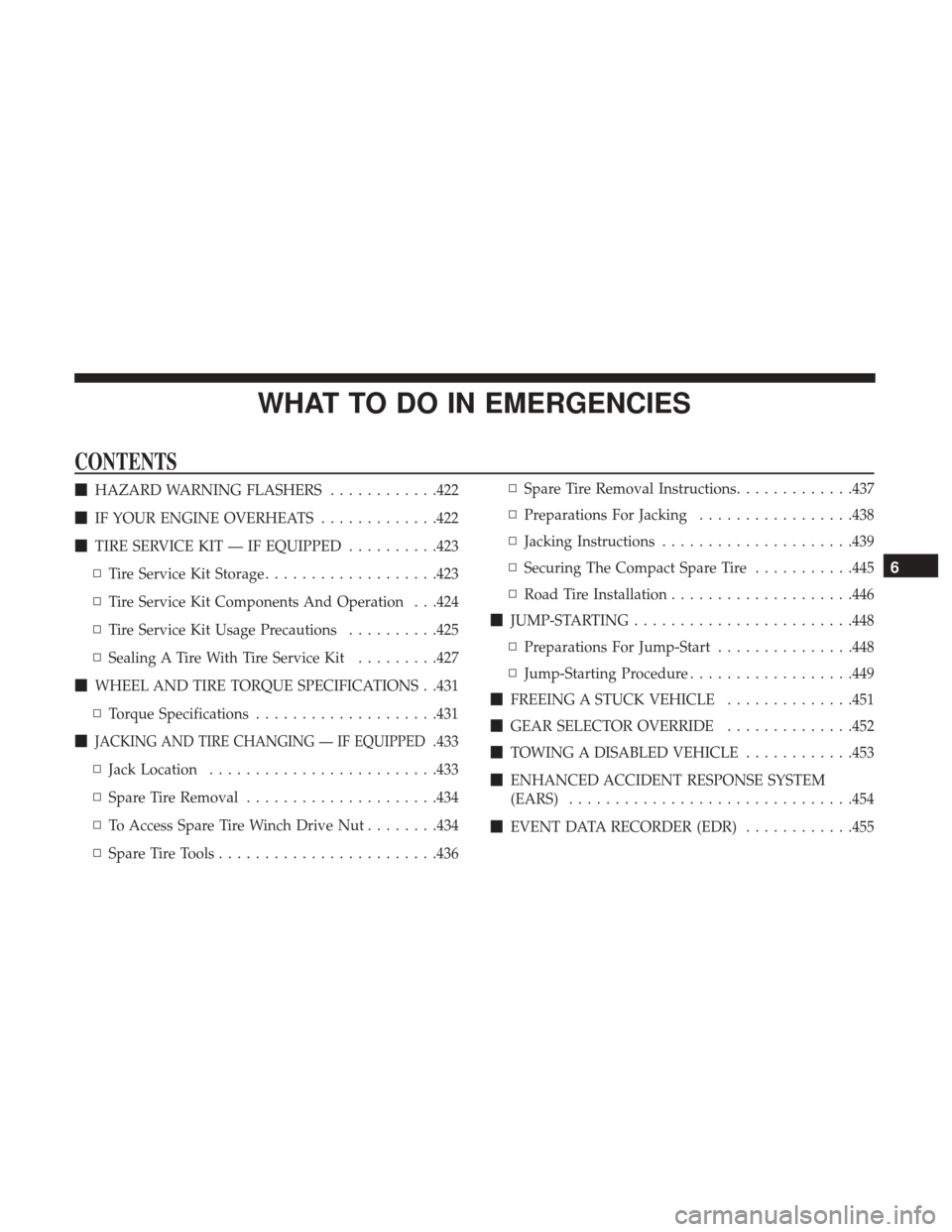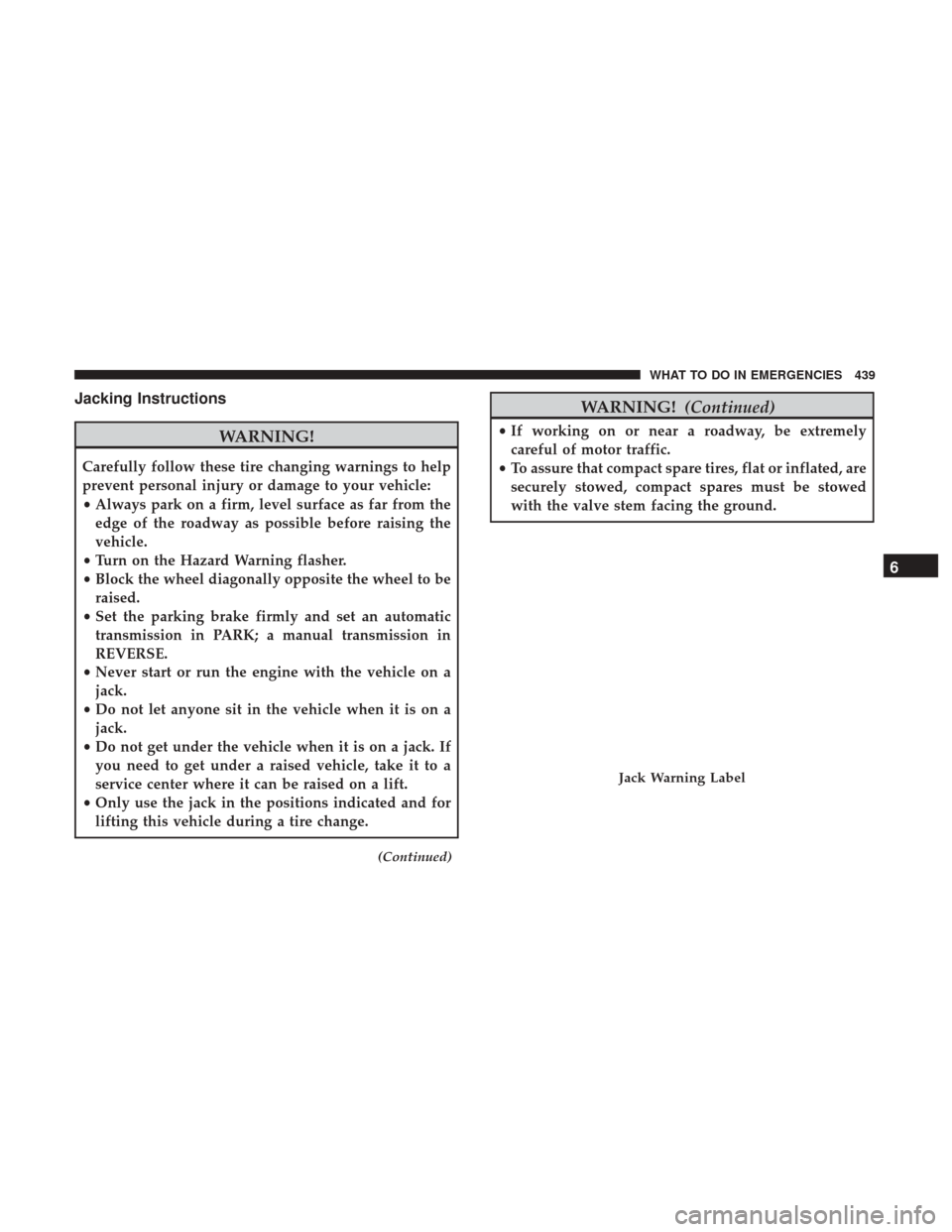Page 420 of 530
Cooling System
To reduce potential for engine and transmission overheat-
ing, take the following actions:
City Driving
When stopped for short periods, shift the transmission into
NEUTRAL and increase engine idle speed.Highway Driving
Reduce speed.
Air Conditioning
Turn off temporarily.
RECREATIONAL TOWING (BEHIND MOTORHOME, ETC.)
Towing This Vehicle Behind Another Vehicle
Towing Condition
Wheels OFF the Ground All Models
Flat Tow NONENOT ALLOWED
Dolly Tow FrontOK
Rear NOT ALLOWED
On Trailer ALLOK
NOTE: When towing your vehicle, always follow appli-
cable state and provincial laws. Contact state and provin-
cial Highway Safety offices for additional details.
418 STARTING AND OPERATING
Page 421 of 530
Recreational Towing — All Models
Recreational towing is allowed ONLY if the front wheels
are OFF the ground. This may be accomplished using a tow
dolly or vehicle trailer. If using a tow dolly, follow this
procedure:
1. Properly secure the dolly to the tow vehicle, followingthe dolly manufacturer’s instructions.
2. Drive the front wheels onto the tow dolly.
3. Firmly apply the parking brake. Place the transmission in PARK.
4. Properly secure the front wheels to the dolly, following the dolly manufacturer’s instructions.
5. Release the parking brake.
CAUTION!
• DO NOT flat tow this vehicle. Damage to the drive-
train will result. If this vehicle requires towing,
make sure the drive wheels are OFF the ground.
• Towing this vehicle in violation of the above require-
ments can cause severe transmission damage. Dam-
age from improper towing is not covered under the
New Vehicle Limited Warranty.
5
STARTING AND OPERATING 419
Page 423 of 530

WHAT TO DO IN EMERGENCIES
CONTENTS
�HAZARD WARNING FLASHERS ............422
� IF YOUR ENGINE OVERHEATS .............422
� TIRE SERVICE KIT — IF EQUIPPED ..........423
▫ Tire Service Kit Storage ...................423
▫ Tire Service Kit Components And Operation . . .424
▫ Tire Service Kit Usage Precautions ..........425
▫ Sealing A Tire With Tire Service Kit .........427
� WHEEL AND TIRE TORQUE SPECIFICATIONS . .431
▫ Torque Specifications ....................431
�
JACKING AND TIRE CHANGING — IF EQUIPPED.433
▫ Jack Location ........................ .433
▫ Spare Tire Removal .....................434
▫ To Access Spare Tire Winch Drive Nut ........434
▫ Spare Tire Tools ........................436 ▫
Spare Tire Removal Instructions .............437
▫ Preparations For Jacking .................438
▫ Jacking Instructions .....................439
▫ Securing The Compact Spare Tire ...........445
▫ Road Tire Installation ....................446
� JUMP-STARTING ........................448
▫ Preparations For Jump-Start ...............448
▫ Jump-Starting Procedure ..................449
� FREEING A STUCK VEHICLE ..............451
� GEAR SELECTOR OVERRIDE ..............452
� TOWING A DISABLED VEHICLE ............453
� ENHANCED ACCIDENT RESPONSE SYSTEM
(EARS) ...............................454
� EVENT DATA RECORDER (EDR) ............455
6
Page 425 of 530
CAUTION!
Driving with a hot cooling system could damage your
vehicle. If temperature gauge reads “H”, pull over and
stop the vehicle. Idle the vehicle with the air condi-
tioner turned off until the pointer drops back into the
normal range. If the pointer remains on the “H”, turn
the engine off immediately, and call for service.
TIRE SERVICE KIT — IF EQUIPPED
Small punctures up to 1/4 inch (6 mm) in the tire tread can
be sealed with Tire Service Kit. Foreign objects (e.g., screws
or nails) should not be removed from the tire. Tire Service
Kit can be used in outside temperatures down to approxi-
mately -4°F (-20°C).
This kit will provide a temporary tire seal, allowing you to
drive your vehicle up to 100 miles (160 km) with a
maximum speed of 55 mph (90 km/h).
Tire Service Kit Storage
The Tire Service Kit is stowed behind the rear left side trim
panel in the rear cargo area.
Tire Service Kit Location
6
WHAT TO DO IN EMERGENCIES 423
Page 428 of 530

•When the Tire Service Kit sealant is in a liquid form,
clean water, and a damp cloth will remove the material
from the vehicle or tire and wheel components. Once the
sealant dries, it can easily be peeled off and properly
discarded.
• For optimum performance, make sure the valve stem on
the wheel is free of debris before connecting the Tire
Service Kit.
• You can use the Tire Service Kit air pump to inflate
bicycle tires. The kit also comes with two needles,
located in the Accessory Storage Compartment (on the
bottom of the air pump) for inflating sport balls, rafts, or
similar inflatable items. However, use only the Air Pump
Hose (7) and make sure the Mode Select Knob (5) is in
the Air Mode when inflating such items to avoid inject-
ing sealant into them. The Tire Service Kit Sealant is only
intended to seal punctures less than 1/4 inch (6 mm)
diameter in the tread of your tire.
• Do not lift or carry the Tire Service Kit by the hoses.WARNING!
•Do not attempt to seal a tire on the side of the vehicle
closest to traffic. Pull far enough off the road to avoid
the danger of being hit when using the Tire Service
Kit.
• Do not use Tire Service Kit or drive the vehicle under
the following circumstances:
– If the puncture in the tire tread is approximately 1/4 inch (6 mm) or larger.
– If the tire has any sidewall damage.
– If the tire has any damage from driving with extremely low tire pressure.
– If the tire has any damage from driving on a flat tire.
– If the wheel has any damage.
– If you are unsure of the condition of the tire or the wheel.
• Keep Tire Service Kit away from open flames or heat
source.
• A loose Tire Service Kit thrown forward in a collision
or hard stop could endanger the occupants of the
vehicle. Always stow the Tire Service Kit in the place
provided. Failure to follow these warnings can result
(Continued)
426 WHAT TO DO IN EMERGENCIES
Page 435 of 530

JACKING AND TIRE CHANGING — IF EQUIPPED
WARNING!
•Do not attempt to change a tire on the side of the
vehicle close to moving traffic. Pull far enough off
the road to avoid the danger of being hit when
operating the jack or changing the wheel.
• Being under a jacked-up vehicle is dangerous. The
vehicle could slip off the jack and fall on you. You
could be crushed. Never put any part of your body
under a vehicle that is on a jack. If you need to get
under a raised vehicle, take it to a service center
where it can be raised on a lift.
• Never start or run the engine while the vehicle is on
a jack.
• The jack is designed to be used as a tool for changing
tires only. The jack should not be used to lift the
vehicle for service purposes. The vehicle should be
jacked on a firm level surface only. Avoid ice or
slippery areas.
Jack Location
The jack, jack handle and winch handle tools are stowed
behind the rear left side trim panel in the rear cargo area.
Turn the two cover latches to release the cover.
Jack And Tool Location
6
WHAT TO DO IN EMERGENCIES 433
Page 436 of 530
Spare Tire Removal
The spare tire is stowed inside a protective cover located
under the center of the vehicle between the front doors by
means of a cable winch mechanism. The “spare tire drive”
nut is located on the floor, under a plastic cap at the front
of the floor console or under front super console forward
bin liner.
To Access Spare Tire Winch Drive Nut
To access the spare tire winch drive nut and lower the spare
tire, you will need to refer to one of the following center
console configurations.
Super Console
For vehicles equipped with the Super Console, the spare
tire winch assembly drive nut is located beneath the
console.
1. Pull the lower drawer out from the rear of the floorconsole to gain clear access of the tire winch drive nut.
Spare Tire Location
Super Console
1 — Lower Drawer
2 — Front Drawer
3 — Front Drawer Liner
434 WHAT TO DO IN EMERGENCIES
Page 441 of 530

Jacking Instructions
WARNING!
Carefully follow these tire changing warnings to help
prevent personal injury or damage to your vehicle:
•Always park on a firm, level surface as far from the
edge of the roadway as possible before raising the
vehicle.
• Turn on the Hazard Warning flasher.
• Block the wheel diagonally opposite the wheel to be
raised.
• Set the parking brake firmly and set an automatic
transmission in PARK; a manual transmission in
REVERSE.
• Never start or run the engine with the vehicle on a
jack.
• Do not let anyone sit in the vehicle when it is on a
jack.
• Do not get under the vehicle when it is on a jack. If
you need to get under a raised vehicle, take it to a
service center where it can be raised on a lift.
• Only use the jack in the positions indicated and for
lifting this vehicle during a tire change.
(Continued)
WARNING! (Continued)
•If working on or near a roadway, be extremely
careful of motor traffic.
• To assure that compact spare tires, flat or inflated, are
securely stowed, compact spares must be stowed
with the valve stem facing the ground.
Jack Warning Label
6
WHAT TO DO IN EMERGENCIES 439